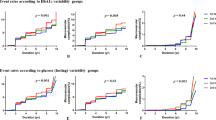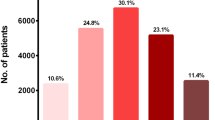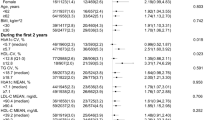Abstract
Coronary heart disease (CHD) is one of the major causes of mortality and morbidity in patients with type 2 diabetes mellitus. In this study, we aimed to assess the association between visit-to-visit variability of fasting blood sugar (FBS), HbA1c, blood sugar 2 h post-prandial (BS2hpp), lipid indices, creatinine, systolic and diastolic blood pressure (SBP, DBP) and incident CHD in patients with type 2 diabetes during a median follow-up of ten years. The current case-cohort study consisted of 1500 individuals with type 2 diabetes, followed up for the occurrence of CHD from 2002 to 2019. The patients had at least four annual follow-ups during which glycemic and lipid profile were measured. Co-efficient of variance (CV) for each parameter was calculated by 10-21 measurements. Cox regression analysis was performed to assess the association between CV of glycemic indices, lipid profile, blood pressure, creatinine, weight and incident CHD during the follow-up period. Hazard ratios (HR) were adjusted for the confounding variables. Glycemic indices variability (i.e., CV-HbA1c, CV-FBS, and CV-BS2hpp), were significantly higher in the group with incident CHD (P=0.034, P=0.042, and P=0.044, respectively). Hazard ratios were 1.42 (95 % CI=1.13-2.09) for CV-HbA1c, 1.37 (95 % CI=1.02-2.10) for CV-FBS, and 1.16 (95 % CI=1.01-1.63) for CV-BS2hpp (P=0.012, P=0.046, P=0.038, respectively). Creatinine was significantly higher in the group with incident CHD (P=0.036) and it was significantly associated with higher incidence of CHD (HR=1.14, 95 % CI=1.02-2.17, P=0.048). Visit to visit variability of glycemic indices of the patients with type 2 diabetes is associated with incident CHD independent of their baseline and mean values.



Similar content being viewed by others
Data availability
Data is available as requested.
Code availability
None.
Abbreviations
- CHD:
-
Coronary heart disease
- DM:
-
Diabetes mellitus
- FBS:
-
Fasting blood sugar
- BS2hpp:
-
Blood sugar 2 h post-prandial
- HDL:
-
High-density lipoprotein
- LDL:
-
Low density lipoprotein
- TG:
-
Triglyceride
- SBP:
-
systolic blood pressure
- DBP:
-
diastolic blood pressure
- CV:
-
Co-efficient variance
- GV:
-
Glucose variability
References
Buse JB, et al. Primary prevention of cardiovascular diseases in people with diabetes mellitus: a scientific statement from the American Heart Association and the American Diabetes Association. Diabetes Care. 2007;30(1):162–72.
Kirkman MS, et al. The association between metabolic control and prevalent macrovascular disease in Type 2 diabetes: the VA Cooperative Study in diabetes. J Diabetes Complicat. 2006;20(2):75–80.
Klein R, et al. The Wisconsin epidemiologic study of diabetic retinopathy. III. Prevalence and risk of diabetic retinopathy when age at diagnosis is 30 or more years. Arch Ophthalmol. 1984;102(4):527–32.
Arca M, Pigna G, Favoccia C. Mechanisms of diabetic dyslipidemia: relevance for atherogenesis. Curr Vasc Pharmacol. 2012;10(6):684–6.
Cushman M, et al. C-reactive protein and the 10-year incidence of coronary heart disease in older men and women. Circulation. 2005;112(1):25–31.
Paprott R, et al. Association between hemoglobin A1c and all-cause mortality: results of the mortality follow-up of the German National Health Interview and Examination Survey 1998. Diabetes Care. 2015;38(2):249–56.
Bilgin S, et al. Does mean platelet volume/lymphocyte count ratio associate with frailty in type 2 diabetes mellitus? Bratisl Lek Listy. 2021;122(2):116–9. https://doi.org/10.4149/bll_2021_017.
Aktas G, et al. Uric acid to HDL cholesterol ratio is a strong predictor of diabetic control in men with type 2 diabetes mellitus. Aging Male. 2020;23(5):1098–102. https://doi.org/10.1080/13685538.2019.1678126.
Kocak MZ, et al. Is Neuregulin-4 a predictive marker of microvascular complications in type 2 diabetes mellitus? Eur J Clin Invest. 2020;50(3):e13206. https://doi.org/10.1111/eci.13206
Kocak MZ, et al. Type 2 diabetes mellitus is more commonly well controlled in younger men compared to older men. Aging Male. 2020;23(5):906–10. https://doi.org/10.1080/13685538.2019.1621833.
Kocak MZ, et al. Neuregulin-4 is associated with plasma glucose and increased risk of type 2 diabetes mellitus. Swiss Med Wkly. 2019;149:w20139. https://doi.org/10.4414/smw.2019.20139.
Atak B, et al. Diabetes control could through platelet-to-lymphocyte ratio in hemograms. Rev Assoc Med Bras (1992). 2019;65(1):38-42. https://doi.org/10.1590/1806-9282.65.1.38.
Kocak MZ, et al. Mean platelet volume to lymphocyte ratio as a novel marker for diabetic nephropathy. J Coll Physicians Surg Pak: JCPSP. 2018;28(11):844–847. https://doi.org/10.29271/jcpsp.2018.11.844.
Chonchol M, et al. Glycosylated hemoglobin and the risk of death and cardiovascular mortality in the elderly. Nutr Metab Cardiovasc Dis. 2010;20(1):15–21.
Saydah S, et al. GHb level and subsequent mortality among adults in the U. Diabetes care. 2009;32(8):1440–6.
Cameron N. Chapter 19 - The measurement of human growth, in human growth and development. In: Cameron N, Bogin B, editors. 2nd ed. Boston: ACHDemic Press; 2012. p. 487-513.
Kao SS, et al. Variability in inpatient serum creatinine: its impact upon short- and long-term mortality. Qjm. 2015;108(10):781–7.
Ceriello A, et al. Oscillating glucose is more deleterious to endothelial function and oxidative stress than mean glucose in normal and type 2 diabetic patients. Diabetes. 2008;57(5):1349–54.
Brownlee M, Hirsch IB. Glycemic variability: a hemoglobin A1c-independent risk factor for diabetic complications. Jama. 2006;295(14):1707–8.
Monnier L, et al. Activation of oxidative stress by acute glucose fluctuations compared with sustained chronic hyperglycemia in patients with type 2 diabetes. Jama. 2006;295(14):1681–7.
Horváth EM, et al. Rapid ‘glycaemic swings’ induce nitrosative stress, activate poly(ADP-ribose) polymerase and impair endothelial function in a rat model of diabetes mellitus. Diabetologia. 2009;52(5):952–61.
Tanaka A, et al. Insulin and nateglinide reduce monocyte adhesion to endothelial cells in Goto-Kakizaki rats exhibiting repetitive blood glucose fluctuation. Biochem Biophys Res Commun. 2006;350(1):195–201.
Esposito K, et al. Inflammatory cytokine concentrations are acutely increased by hyperglycemia in humans: role of oxidative stress. Circulation. 2002;106(16):2067–72.
Liang S, et al. Glucose variability for cardiovascular risk factors in type 2 diabetes: a meta-analysis. J Diabetes Metab Disord. 2017;16:45.
Wang C, et al. Platelet PI3Kγ contributes to carotid intima-media thickening under severely reduced flow conditions. PLoS One. 2015;10(6):e0129265.
Zhang JW, et al. Effect of glycemic variability on short term prognosis in acute myocardial infarction subjects undergoing primary percutaneous coronary interventions. Diabetol Metab Syndr. 2014;6:76.
Kuroda M, et al. Effects of daily glucose fluctuations on the healing response to everolimus-eluting stent implantation as assessed using continuous glucose monitoring and optical coherence tomography. Cardiovasc Diabetol. 2016;15:79–79.
Wright RJ, Frier BM. Vascular disease and diabetes: is hypoglycaemia an aggravating factor? Diabetes Metab Res Rev. 2008;24(5):353–63.
Wang A, Liu X, Xu J, Han X, Su Z, Chen S, Zhang N, Wu S, Wang Y, Wang Y. Visit-to-visit variability of fasting plasma glucose and the risk of cardiovascular disease and all-cause mortality in the general population. J Am Heart Assoc. 2017;6(12):e006757. https://doi.org/10.1161/JAHA.117.006757.
Jang JY, et al. Visit-to-visit HbA1c and glucose variability and the risks of macrovascular and microvascular events in the general population. Sci Rep. 2019;9(1):1374.
Ghouse J, et al. Visit-to-visit variability of hemoglobin A(1c) in people without diabetes and risk of major adverse cardiovascular events and all-cause mortality. Diabetes Care. 2019;42(1):134–41.
Cardoso CRL, et al. Long-term visit-to-visit glycemic variability as predictor of micro- and macrovascular complications in patients with type 2 diabetes: The Rio de Janeiro Type 2 Diabetes Cohort Study. Cardiovasc Diabetol. 2018;17(1):33.
McClure Yauch L, Velazquez E, Piloya-Were T, Wainaina Mungai L, Omar A, Moran A. Continuous glucose monitoring assessment of metabolic control in east African children and young adults with type 1 diabetes: A pilot and feasibility study. Endocrinol Diab Metab. 2020;3:e00135. https://doi.org/10.1002/edm2.135.
Bangalore S, et al. Visit-to-visit low-density lipoprotein cholesterol variability and risk of cardiovascular outcomes: insights from the TNT trial. J Am Coll Cardiol. 2015;65(15):1539–48.
Lissner L, et al. Variability of body weight and health outcomes in the Framingham population. N Engl J Med. 1991;324(26):1839–44.
Kim MK, Han K, Kim HS, Park YM, Kwon HS, Yoon KH, Lee SH. Cholesterol variability and the risk of mortality, myocardial infarction, and stroke: a nationwide population-based study. Eur Heart J. 2017;38(48):3560–66. https://doi.org/10.1093/eurheartj/ehx585.
Wan EYF, Yu EYT, Chin WY, Barrett JK, Mok AHY, Lau CST, Wang Y, Wong ICK, Chan EWY, Lam CLK. Greater variability in lipid measurements associated with cardiovascular disease and mortality: A 10-year diabetes cohort study. Diabetes Obes Metab. 2020;22(10):1777–88. https://doi.org/10.1111/dom.14093.
Zhou TL, et al. Blood pressure variability, arterial stiffness, and arterial remodeling. Hypertension. 2018;72(4):1002–10.
Prenner SB, Chirinos JA. Arterial stiffness in diabetes mellitus. Atherosclerosis. 2015;238(2):370–9.
Nichols WW, Nicolini FA, Pepine CJ. Determinants of isolated systolic hypertension in the elderly. J Hypertens Suppl. 1992;10(6):S73-7.
Chiriacò M, et al. Association between blood pressure variability, cardiovascular disease and mortality in type 2 diabetes: A systematic review and meta-analysis. Diabetes Obes Metab. 2019;21(12):2587–98.
Acknowledgements
Authors wish to thank patients for their participation and kind cooperation.
Author information
Authors and Affiliations
Contributions
Alireza Esteghamati, Marjan Mouodi, and Soghra Rabizadeh contributed to conception. Fatemeh Moosaie, Alipasha Meysamie, and Fatemeh Dehghani Firouzabadi contributed to data analysis. Ali Sheikhy, Aida Fallahzadeh, and Niloofar Deravi contributed to drafting. Fatemeh Moosaie, Seyede Marzie Fatemi Abhari, and Manouchehr Nakhjavani contributed to revision.
Corresponding author
Ethics declarations
Conflict of interest
None.
Additional information
Publisher’s Note
Springer Nature remains neutral with regard to jurisdictional claims in published maps and institutional affiliations.
Fatemeh Moosaie and Marjan Mouodi contributed equally as co-first authors.
Rights and permissions
About this article
Cite this article
Moosaie, F., Mouodi, M., Sheikhy, A. et al. Association between visit-to-visit variability of glycemic indices and lipid profile and the incidence of coronary heart disease in adults with type 2 diabetes. J Diabetes Metab Disord 20, 1715–1723 (2021). https://doi.org/10.1007/s40200-021-00930-z
Received:
Accepted:
Published:
Issue Date:
DOI: https://doi.org/10.1007/s40200-021-00930-z




